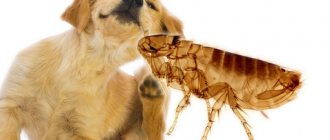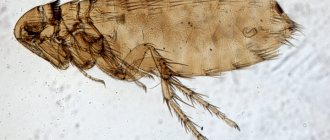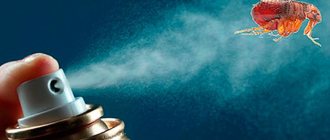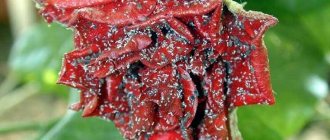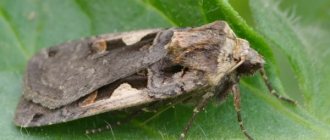The situation is not pleasant when fleas are suddenly discovered on a recently purchased puppy, and even more so in a litter, given that the younger the baby is, the smaller the choice of suitable means for removing bloodsuckers.
In many ways, the method of ridding a dog of fleas that plague him will also depend on where the baby is kept - in an apartment or on the street.
To no less an extent, the choice of means for baiting parasites is influenced by the circumstance - whether the puppy is in the litter with its mother or has already been separated from its family and is living with new owners.
Where does a small puppy get fleas?
There are several ways for a small dog to become infected with fleas, and the older he is, the more there are, and the higher the risk of having bloodsuckers.
- The smallest puppies are most likely to become infected with parasites from their mother, who brought them to the family on her own, as she is forced to periodically leave the puppies.
- A puppy that has already been handed over to new owners could have flea eggs, larvae or adults remaining on its fur, which, during reproduction, began to pester the baby more actively.
- When the dog has already gone out into the world, then on the street, along with new impressions, the possibility of a flea attack awaits him, and it is possible that some frisky flea will jump on the puppy.
- If one or more pets live in the same room, then this is also a likely source of fleas in the baby.
Important! If there are other animals living in the house, it is better to periodically check them for the presence of bloodsuckers in order to remove them in time and not endanger the puppy.
What to do if your dog has fleas
Having discovered parasites in a dog, you need to act immediately to avoid their massive spread.
- Choose a suitable anti-flea product, following the advice of a veterinarian.
- You need to fight fleas strictly according to the instructions for the drug. And if repeated treatment is prescribed there, you should not neglect it - this can lead to a massive proliferation of parasites.
- Treat the apartment followed by wet cleaning.
- As a preventative measure, you should limit your pet’s contact with stray animals.
Accurate and timely implementation of these tips will help cure your pet of annoying parasites and prevent their occurrence. If there is a strong accumulation of fleas in a house or apartment, it is recommended to use the service of a company that will carry out pest control at a professional level.
I found traces of fleas on my baby, there are no fleas themselves, but there are black specks. I read that these are flea excrement. It doesn’t really itch very much, but at the base of the tail it begins to gnaw on itself and rubs against the carpet. What's a good thing to buy? Shampoo or collar? Drops? But I've never used drops, how do I calculate the dose??
How dangerous are flea bites for a puppy?
Flea bites are much more dangerous for babies than for adult dogs. In addition to the severe itching, which bothers adult dogs and makes the baby whine, constantly itch and cannot find a place for himself, fleas on a small puppy are dangerous for a number of reasons.
- Puppies have not yet developed their immune system, and they are often defenseless against infectious agents that are transmitted by fleas through a bite.
- Children are much more likely to suffer from allergic reactions from flea saliva enzymes.
- With extensive bites, anemia develops due to significant blood loss relative to the weight of the puppy.
- The worms with which fleas infect their prey are much more difficult for children to tolerate: exhaustion sets in, stool changes, fur becomes dull, and eyes become sour.
Therefore, even before mating, it is necessary to treat the bitch with a long-lasting effective remedy so that during the period of whelping and lactation she is protected from parasites, and along with her the future brood. These can be drops, a tablet, or, as a last resort, a collar, which is best removed after conception.
Causes and signs of infection
Some argue that a dog that lives in an apartment and occasionally goes outside cannot become a carrier of fleas. However, this opinion is not correct. Bloodsuckers parasitize not only yard dogs, but can also feel comfortable on humans. In this case, it is he who is the carrier and is able to bring fleas into the house, on clothes or shoes. Having discovered a source of food, bloodsuckers settle and multiply fruitfully in the dog’s fur.
When piercing the skin, the flea injects saliva into the wound, which causes:
- Severe itching, accompanied by redness and swelling; Skin and viral diseases; Hair loss; Allergic reactions; Anemia in puppies, which can result in death.
How can you tell if your dog has fleas? It’s not difficult to verify their presence; the main thing is to take a close look at the animal’s behavior.
If your pet is concerned about frequent itching of different parts of the body. Flea bites on the dog are visible in the form of wounds and redness. The animal's fur is strewn with white grains resembling salt (this is what flea eggs look like), small black inclusions (larvae) and the remains of insects (excrement).
Fleas on dogs You can detect fleas on a dog while swimming, when the parasites panic and they jump into the water en masse or cluster around the head. The presence of bloodsuckers can be determined by visual contact or by combing with a thick comb (the parasites remain between the teeth).
How to remove fleas from puppies in the first month of life
When the baby is not yet a month old, he is usually still with his mother and brothers. As a rule, babies are given away no earlier than 1.5 - 2 months, although there are exceptions when the puppy leaves its native land before it reaches the age of one month.
Therefore, methods for removing fleas from a puppy who is 1 month old or even less will vary, taking into account the presence or absence of a canine family.
How to protect puppies in the litter from fleas
A nursing bitch can pick up parasites on a walk, where her owner is forced to take her out to perform her natural needs. If, while pregnant, she was not treated with insecticides, since this is difficult during whelping, then this is the most likely reason for the appearance of fleas, because then nothing often prevents the attack of bloodsuckers, and they move to the mother, and from her to the entire litter.
To avoid infecting a nursing bitch with fleas, and as a result, all offspring, you can take several routes.
- Cover the area where the bitch and puppies are with fresh wormwood or tansy, and outside the grass growing season, scatter the dry mixture or use a strong decoction, treating the litter with a spray bottle. In case of accidental introduction of parasites, such manipulations should force them to leave the dog family. But this method is only good for an enclosure, a booth or a canopy, that is, outside a human home.
- The aromatic essential oils of lavender, eucalyptus, clove and mint have a similar principle, being strong repellents. A solution with a few drops of this product can be sprayed periodically around the dog droppings. This method will both protect against flea infestation and remove them at a very early stage, before they breed.
- To protect the bitch nursing puppies, especially those living in the same room with their owners, you can put a scarf or scarf dipped in the essential oil of eucalyptus, lavender, mint or clove around her neck before a walk.
- Protective tablets, drops and sprays are produced especially for dog mothers who feed puppies. Your veterinarian will be able to recommend a specific product that is best for your dog. Drops and sprays, in addition to protecting the bitch, protect the entire litter from fleas.
During the period of feeding puppies, it is important to observe the behavior of the bitch to see if she is itching. If this happens often and the bitch behaves restlessly, then it is necessary to check her for fleas, and if parasites are found, remove them immediately.
How to kill existing fleas on a one-month-old puppy
If a 1-month-old puppy has fleas and they actively bite him, then repelling him will not help much; you will have to decisively get rid of the parasites, acting carefully so as not to harm the baby.
If this is a litter, then each baby will have to be processed separately, not forgetting about the mother.
- We prepare a strong decoction of wormwood, tansy, or a mixture of both. You can also use calamus, wild rosemary or mint. We immerse the puppy in the warm broth, making sure that the water does not get on the head, especially the ears, nose and eyes. You need to keep the dog in such a bath for at least 15 minutes. After drying, it must be thoroughly combed over white paper or cloth; fallen fleas should be burned or drowned in the sewer.
- Another good way to remove parasites from a baby under 1 month old is to bathe him in tar soap. After soaking the baby in warm water, you need to soap it generously, then wrap it in film, and wrap it in something warm on top so that the puppy does not freeze. After waiting for at least 20 minutes, unwrap and wash off the foam along with the dead parasites, dry the baby and then comb to remove possible surviving fleas, their larvae and eggs.
- Shampoos for the smallest puppies have similar properties. For example, such a product is Doctor Zoo, which does not contain insecticides, but only natural ingredients. The foam should be kept for no more than 5 minutes, then rinsed off. For very tiny puppies, affected by the abundance of bloodsuckers, you can apply tightly whipped foam directly to the fur with a sponge and dry it.
Important! Before releasing the treated puppy to its brothers, it should be thoroughly dried so that the other puppies do not get foamy and get poisoned!
Popular flea remedies
Vet pharmacies offer a huge selection of anti-flea products. When purchasing a medicine, you need to make sure that it is suitable for your pet’s age, and its use is not prohibited for representatives of a particular breed.
Anti-flea collars
Collars are mostly used to prevent infection. The collar is impregnated with a substance that repels insects. Its effect usually lasts from 3 weeks to 2-3 months. For best results, experts recommend putting on a collar after treating your puppy with flea shampoo. Popular manufacturers:
- Beafar;
- Leopard.
Drops
Drops are an effective flea remedy for puppies, which can be used if the animal is alone in the house or can be temporarily isolated from others. For puppies who are under the care of their mother, flea drops are not recommended, as the mother may lick them off while washing the puppy.
The solution is applied to the skin in the withers area. The most popular are combined drops of complex action, which both kill and repel parasites. Most popular:
- Frontline Spot;
- Advocate;
- Celandine.
Shampoos
You can poison fleas on puppies using shampoos that contain insecticides. Due to the low concentration and toxicity of the active substances, shampoos are approved for puppies starting from 4-6 weeks of age. Most products contain auxiliary substances that care for the coat.
Shampoo
Products in demand:
- Beafar;
- Celandine;
- Phytoelite;
- Doctor ZOO.
Sprays and aerosols
Many puppy owners choose sprays to combat parasites and protect against them. They are chosen for their ease of application and almost instant effect. The protective effect of the spray lasts 3-5 weeks.
You can treat your puppy against fleas with the following sprays:
- Stronghold;
- Leopard;
- Frontline;
- Beafar.
How to deal with fleas on a 2 month old puppy
2 months after giving birth, the bitch ends the feeding period, the offspring have developed immunity, increased body weight, milk teeth have grown, and a varied diet is available. At this age, you can already hand the puppy over to new, caring hands.
Accordingly, it will be easier to exterminate fleas on a 2-month-old puppy. Long-term preventive measures are now also becoming more accessible.
- From this age, the range of anti-flea shampoos expands significantly, but up to six months it is better to give preference to products with a minimal content of poisons, or better without them at all. If there are several puppies, then it is necessary to thoroughly dry each treated baby before releasing it to the others.
- Collars specifically designed for puppies that are infused with essential oils are also now becoming available. But when there are several puppies, there is a danger that the kids will chew each other’s collars, so it is better to buy this product for the only puppy in the family.
- Drops on the withers can also be used on such puppies, but carefully look at the instructions for the age at which they are indicated. Again, they will be effective and safe for a child living separately, otherwise the rest may suffer from poisoning.
- Sprays work excellently, allowing you to quickly and completely remove bloodsuckers, which are allowed for puppies of this age, but, like other products with insecticides, are contraindicated in the litter.
That is, if the baby is in new hands and is the only one, all of the above methods will come in handy. After all, many pet product manufacturers have taken care of how to effectively remove fleas from a 2-month-old puppy without harming him.
Expulsion of parasites from the mother
If you do not free the bitch from insects, they will move onto the newly washed puppy. There is no hope that she is free from pulicem: if parasites are found on a puppy, then they will definitely be on his mother.
The selection of pest control agents for bitches is carried out based on the following considerations:
- The drug must be safe for the mother.
- The active substance of the anti-flea agent should not be excreted in milk, so as not to have a toxic effect on the cubs.
- The insecticide should dry quickly and become insoluble in the saliva of puppies, who love to caress their mother with licks.
Stronghold drops
All the above-mentioned properties are possessed by the drug Stronghold, the main component of which is selamectin. The medication is produced in the form of pipettes applied to the skin between the shoulder blades. Drying time is two hours. After this, you can allow the puppies to approach their mother. Caring owners get rid of fleas before mating, refreshing the protection of the puppy and lactating female monthly. The only drawback of Stronghold is its relative high cost.
After treatment, the mother needs to examine the puppies for several days to see if pulicem has reappeared. The fact is that complete protection of the dog from the ectoparasite occurs within 24 hours after applying the drug. A few days later, mom will be completely free of arthropods.
Once puppies reach six weeks of age, they can be protected against ectoparasites using Stronghold.
Anti-flea treatment for apartments
How to remove fleas from older puppies
For an older dog, most insecticidal preparations against parasites widely available on the market are suitable. After reaching six months, you can use adult products, taking into account weight and age restrictions.
- Shampoos;
- sprays;
- pills;
- drops on the withers;
- collars.
Here it is important to take into account the tendency to allergies, the general condition of the dog, and the degree of flea damage. If there are a lot of bloodsuckers, then for a better result you can combine means: wash the puppy with shampoo, and then treat it with a spray or drops, or put on a collar, or even give him a pill. You decide!
Traditional methods
They were mentioned a little earlier, as they are applicable for newborn babies. Traditional methods are based on the use of herbs. That is why they are so harmless for newly born puppies.
If the mother and offspring are in an enclosure or in a room separate from human habitation, then it would be good to place bunches of herbs such as wormwood, lavender, and bugs around the bed. They have a pungent odor that will repel nasty insects. For the convenience of animals, the bunches can be replaced with powder from the same plants. Herbs are safe even for babies, who may accidentally get the herb inside.
If animals live in the house, then the litter and the surrounding area should be treated with water with the addition of a couple of drops of essential oil of the same lavender, lemon, menthol or eucalyptus. This method also has a deodorizing and antimicrobial effect.
You can remove fleas from dogs at home using folk remedies. The advantage of this control method is safety, availability and low cost. There are the following folk remedies for fleas for dogs:
- Herbs;
- Essential oils;
- Garlic and onion;
- Pine branches and sawdust;
- Lemon;
- Apple vinegar;
- Laundry soap.
Treating dogs for fleas with wormwood is one of the old and effective means of fighting insects. The bitter taste and specific smell of grass is what fleas are afraid of. Therefore, you need to know how to get rid of fleas on a dog using wormwood. It is enough to prepare a herbal decoction and bathe the animal in it.
You can get rid of fleas on your dog using hellebore solution. This product has strong antiparasitic properties and is used to kill not only fleas, but also ticks and worms. The drug should be used with caution, as it is toxic, and an overdose can lead to severe poisoning.
Laundry soap, onion, garlic and wormwood
Garlic
Garlic is another effective flea remedy for dogs. A couple of garlic cloves need to be crushed or finely chopped with a knife, pour a glass of water and leave for 8 hours. The infusion is used to wipe the dog’s fur in places where it cannot lick the drug (head and neck area). Processing should be done very carefully, as garlic is toxic to dogs. Once in an animal's body, it can lead to poisoning and even death.
We suggest you read: How a flea differs from a louse
Onions have a similar effect. To cure a dog of fleas, you need to make a soap solution from grated laundry soap mixed with a glass of water. Next, chopped onions are added to this mass. The resulting mixture is applied to the dog’s fur and left for 5-10 minutes. Then rinse thoroughly with water. If there is a large cluster of fleas, the treatment can be repeated.
Laundry soap
You can remove fleas from your dog using homemade shampoo. To do this, dissolve laundry soap in a decoction of eucalyptus and add a few drops of tea tree or cedar oil. The resulting mass is applied to the pet’s fur, foaming thoroughly. Wash off after 10 minutes. This is a very good remedy for fleas, and unlike chemical drugs it will not cost much.
Essential oils
This is an equally effective cure for parasites. Essential oils of lavender, eucalyptus, tea tree or citrus perfectly repel fleas. A flea-ridden dog will quickly get rid of parasites if you treat the animal with a solution using one or another ingredient. To do this, add a few drops of oil to a small amount of water and spray the dog. The oil can also be used to bathe your pet.
Essential oils, pine needles and vinegar
If you discover symptoms of parasite infection in a dog living in your yard, you must apply any of the methods described above. It is better to use pine sawdust or finely chopped twigs as bedding for the animal to rest. The effect can be enhanced if you add wormwood branches to them. This “nuclear” remedy will help get rid of parasites for a long time.
How to remove fleas from dogs using vinegar? It is enough to mix apple cider vinegar with water in a ratio of 1:3 and treat the fur of your four-legged friend with the resulting product. After an hour, the animal’s hair should be combed to remove dead insects, their larvae and eggs.
Prevention
After a long fight against pests, you don’t want them to come back. Therefore, you should follow basic measures that will protect not only a small puppy, but also an adult dog from infection:
- avoid allowing the animal to come into contact with stray animals;
- regularly inspect your pet and periodically treat it with flea repellents;
- after getting rid of parasites, it is necessary to thoroughly vacuum the area and treat the surrounding area;
Fleas are not the worst thing that can happen to a pet; this phenomenon is quite common. The main thing is to notice this in time and begin effective treatment. It is necessary to carefully select the product; as you can see, they are quite varied and are not suitable for everyone. It is worth being patient and willing to help your pet, because no one except the owner will save him from endless itching and bites. Because we are responsible for those we have tamed.
